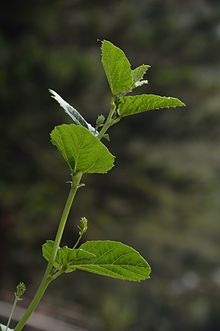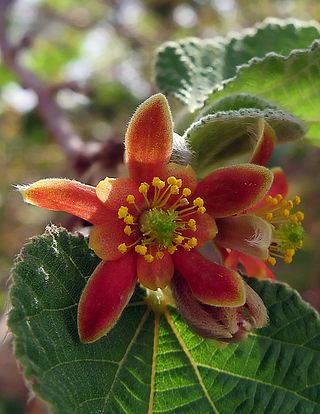
Grewia villosa is a shrub, often scrambling and hardly exceeding 4 m in height. Leaves are fairly large, serrated and heart-shaped. It grows naturally, mainly in dry habitats. It is common in most of the semi-arid parts of Eastern Africa but may now be rare in parts of its natural distribution. It can be seen in Ein Gedi oasis in Israel, and in South Africa, where it is common. Its ripe copper-coloured fruits are eaten in East Africa.

Ipomoea pes-caprae, also known as bayhops, bay-hops, beach morning glory or goat's foot, is a common pantropical creeping vine belonging to the family Convolvulaceae. It grows on the upper parts of beaches and endures salted air. It is one of the most common and most widely distributed salt tolerant plants and provides one of the best known examples of oceanic dispersal. Its seeds float and are unaffected by salt water.

Amaranthus graecizans, the Mediterranean amaranth or short-tepalled pigweed, is an annual species in the botanical family Amaranthaceae. It is native to Africa, southern Europe, East Asia to India and Central Asia. It is naturalized in North America. More general common names include tumbleweed and pigweed.
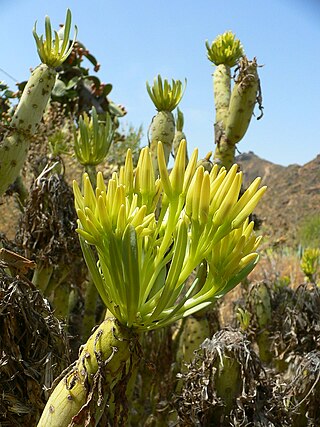
Kleinia is a genus of African flowering plants in the sunflower family. Kleinia contains around 50 species and is distributed from the Canary Islands, throughout Tropical Africa to India and Arabia. It is closely related to the genus Senecio but is distinguished primarily by having succulent stems and/or leaves.
Blepharis dhofarensis is a species of plant in the family Acanthaceae. It is a shrub that grows to around 5m tall and is found in Oman and Yemen. Blepharis dhofarensis grows on wet escarpment woodlands and it prefers dense thickets on steep slopes. It is threatened by habitat loss. Recent molecular work has placed it in the genus Acanthus instead of Blepharis.
Maytenus dhofarensis is a species of plant in the family Celastraceae and is found in Oman and Yemen. It is an intricately branched spiny shrub or small tree with its leaves arranged alternately or clustered on short shoots. The flowers have white or cream petals and the fruit are purple or red. It is threatened by habitat loss.

Ruttya fruticosa, also known as jammy mouth or jêmbekkie, is a shrub which is native to Africa. It can be found in South Somalia to Tanzania and in the woodlands of Dhofar, Oman. The name Ruttya was named in honour of Dr John Rutty and fruticosa means shrubby and refers to the habit of the plant.
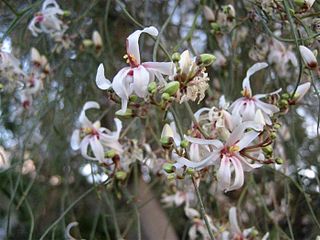
Moringa peregrina is a species of flowering plant in the family Moringaceae that is native to Arabian Peninsula Horn of Africa and Southern Sinai, Egypt and can be found throughout Arabia, Egypt and as far north as Syria. Moringa peregrina grows on rocky wadis and on cliffs in drier areas.

Plumbago zeylanica, commonly known as Ceylon leadwort, doctorbush or wild leadwort, is a species of plumbago with a pantropical distribution. Carl Linnaeus described the paleotropical P. zeylanica and Neotropical P. scandens as separate species, but they are currently considered synonymous.

Bakuchiol is a meroterpene in the class terpenophenol.

Lycium shawii, desert thorn or Arabian boxthorn is a species of thorny shrub adapted to desert environments, and can be found throughout the Arabian peninsula, and some places in Africa. The thin leaved, rigid bush grows up to 3 metres high, with a lot of branches and alternating spines that vary in size, and grow along the branches and on their tips. The leaves narrow towards their base. It produces small whitish-pink or purple flowers from September until April, and red pea-sized seedy berries that are edible. Habitats include gravel plains and foothills up to 4,000 ft (1,200 m), as well as wadis. Plants often growing nearby include Acacia tortilis and Prosopis cineraria.
Withania qaraitica is a shrubby and perennial herb up to one metre tall with bright orange-red seeds patterned with honeycomb-like markings, pale yellowish brown. It has only been found in Dhofar, but may occur in wet woodlands over the border in south Yemen. It is closely related to two species, Withania adunenis and W. riebeckii. Withania qaraitica occurs commonly in the wet woodlands however can be found around settlements where they have frequently been transplanted.
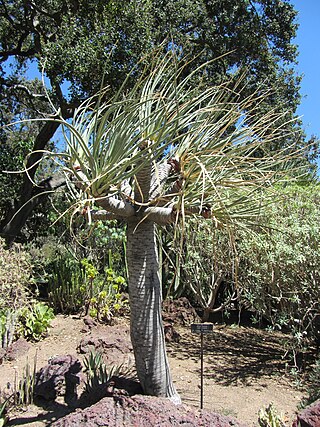
Dracaena serrulata also called the Arabian or Yemen Dragon Tree is a distinctive tree reaching around 5m tall with a single trunk. It is found in the dry escarpment mountains of southwestern Arabia from Oman, South Yemen and Saudi Arabia.
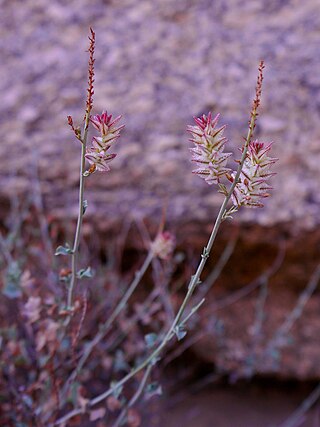
Dyerophytum is a small genus of three species of plants distributed in India, southern Arabia, Socotra and southern Africa.
Dyerophytum socotranum is a small shrub growing up to 2m tall, rather glaucous and covered in white mealy powder. It has yellow flowers.
Pancratium maximum is a perennial glabrous herb that grows up to 30 cm tall arising from a bulb. It is endemic to south western Arabia.
Kleinia odora is found in Ethiopia, Somalia, Yemen and Saudi Arabia. It is distinguished by having succulent stems or leaves. It is common in low dry hills along coastal plains. It forms large clumps bearing dense clusters of cream or whitish flowers on the tips of the pencil-like stems.
Senna holosericea is a perennial herb with yellow flowers that is native to the Arabian peninsula, Chad, Djibouti, Egypt, Eritrea, Ethiopia, India, Pakistan, Socotra, Somalia and Sudan.
Cyphostemma ternatum is a perennial climbing herb that grows up to 2m. It is edible and distributed throughout Northeast Africa to South Arabia. ternatum in Latin means "arranged in threes" and alludes to the arrangement of the leaves.
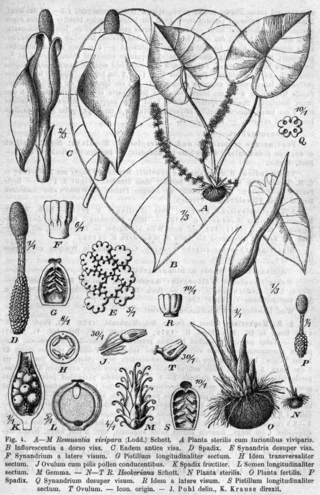
Remusatia vivipara also called hitchhiker elephant ear is a perennial herb growing up to 50 cm tall in the genus Remusatia. It is widespread throughout the world, growing in temperate climates.
